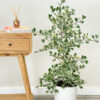Description
Grow Your Own Delicious Bananas, AnywhereOne of the most fascinating features of the Super Dwarf Banana Tree is its ability to produce small, sweet, edible bananas even in limited space. Though smaller than commercial varieties, these bananas still offer a tasty and nutritious treat. The plant’s compact size and fruit-bearing capability make it an ideal option for urban gardeners or those with limited outdoor space.In addition to its fruit production and visual appeal, the Super Dwarf Banana Tree serves as an excellent conversation piece, showcasing the adaptability and resilience of tropical plants. With proper care and attention, this unique, space-saving cultivar can bring a touch of the tropics to any home or garden.Caring for your Super Dwarf BananaCaring for a Super Dwarf can be a rewarding experience, as it not only adds a touch of tropical beauty to your home or garden but also provides small, sweet bananas for you to enjoy. The compact size and fruit-bearing capabilities of this unique plant make it an ideal choice for urban gardeners or those with limited space. Here are some essential tips for growing and caring for your Super Dwarf Banana Tree.Location and Light RequirementsSuper Dwarf Banana Trees thrive in full sun to partial shade. Ensure that your plant receives at least 6 hours of sunlight daily. When growing the plant indoors, place it near a bright window, preferably facing south or west, to provide the necessary light. If natural light is limited, consider supplementing with artificial grow lights to support healthy growth and fruit production.Soil and DrainageWell-draining soil is crucial for the health of your Super Dwarf Banana Tree. A loose, fertile potting mix with high organic matter content will provide the necessary nutrients and aeration for the plant’s roots. When planting in a container, make sure it has drainage holes to prevent waterlogging and root rot. Adding perlite, vermiculite, or coarse sand to the potting mix can further improve drainage.Watering and HumidityRegular watering is essential for the Super Dwarf Banana Tree, as its large leaves lose water rapidly through transpiration. Keep the soil consistently moist but not waterlogged. During the growing season, you may need to water your plant every two to three days, depending on the size of the container and environmental conditions. In colder months, reduce the frequency of watering, as the plant’s growth will slow down.Maintaining a humid environment is beneficial for the Super Dwarf Banana Tree, particularly when grown indoors. You can increase humidity by placing a tray of water filled with pebbles beneath the plant, misting the leaves regularly, or using a humidifier.Fertilizing and Nutrient RequirementsSuper Dwarf Banana Trees are heavy feeders, requiring regular fertilization to support their growth and fruit production. Use a balanced, slow-release fertilizer, such as a 10-10-10 or 14-14-14 formula, applied according to the manufacturer’s instructions. You can also supplement with organic matter, like compost or well-rotted manure, to provide additional nutrients. During the growing season, apply fertilizer every four to six weeks. Reduce the frequency of fertilization in the winter months.Pruning and MaintenancePruning is essential for maintaining the health and appearance of your Super Dwarf Banana Tree. Remove dead or damaged leaves as they appear, using a sharp, clean pair of pruning shears. After the plant produces fruit, cut the fruiting stalk back to the base, as it will not produce fruit again. New suckers will emerge at the base of the plant, which can be left to grow and replace the older stalk, or can be removed and potted separately to create new plants.Pest and Disease ManagementSuper Dwarf Banana Trees can be susceptible to common pests such as aphids, spider mites, and mealybugs. Regularly inspect your plant for any signs of infestation and treat promptly with insecticidal soap or neem oil, following the manufacturer’s instructions. Maintaining proper watering and humidity levels can help prevent some diseases, such as fungal infections.





